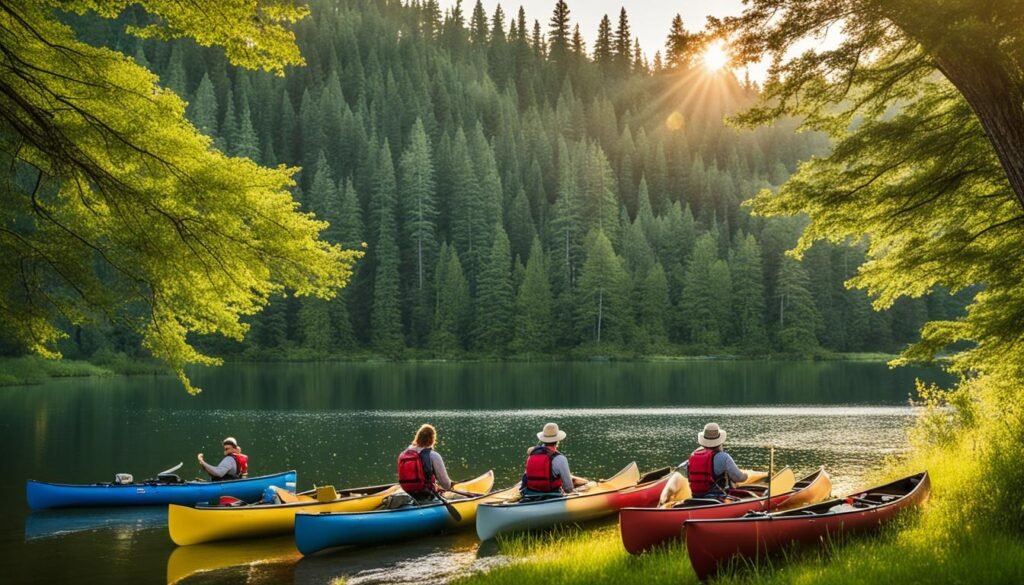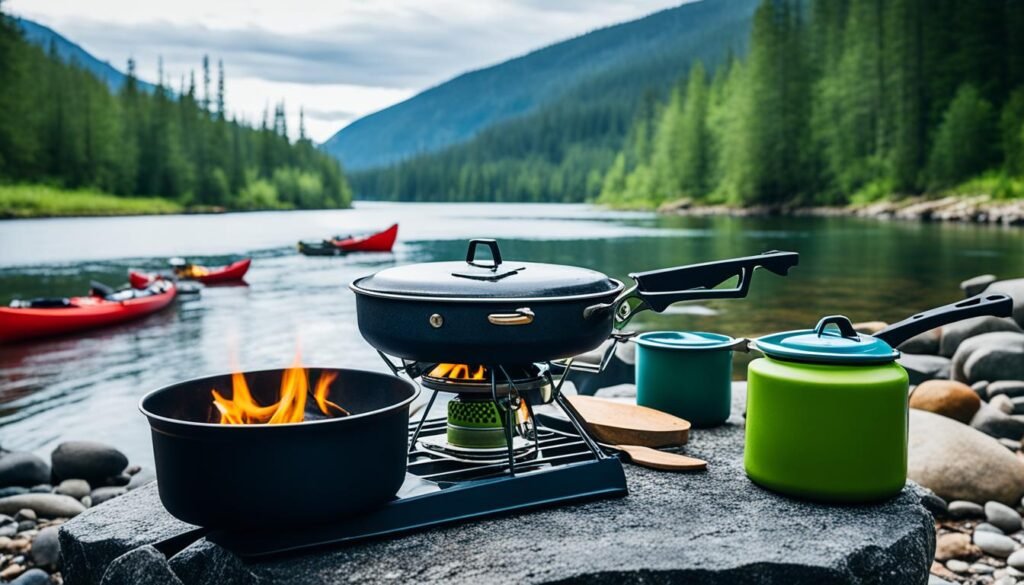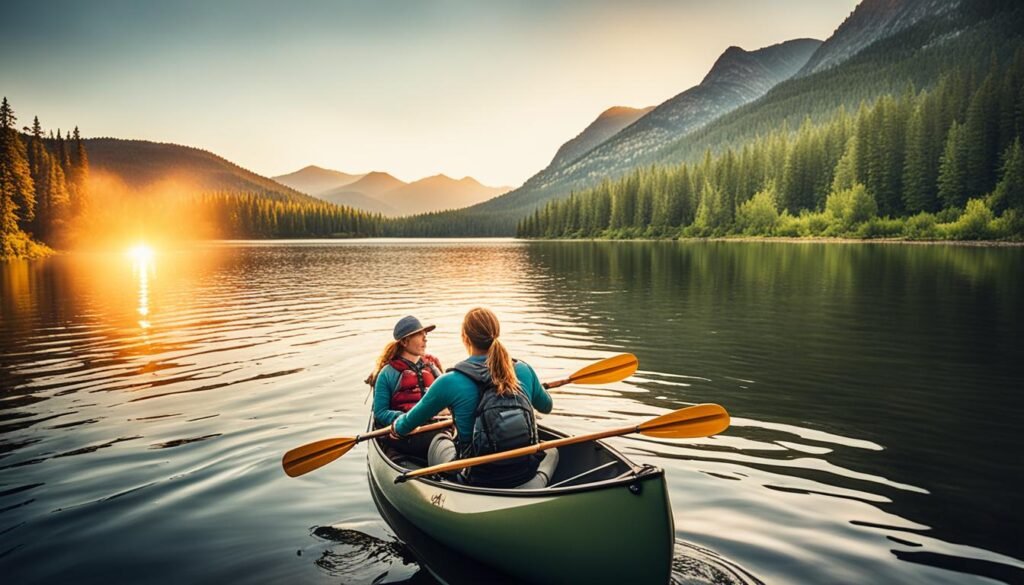Ever thought about your canoe camping trip’s impact on nature?
Canoeing blends adventure with natural peace. Reaching a campsite by water is special. But we must protect nature for others. The Leave No Trace Center teaches us how. I’ll share ways to camp without harming nature, following their advice.
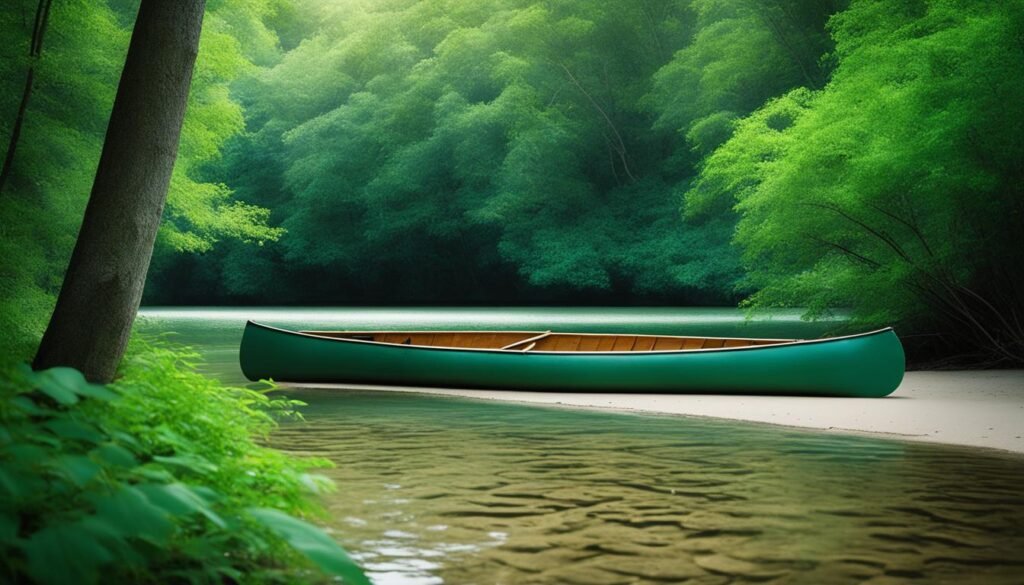
Research shows Leave No Trace works. It cuts soil loss by up to 92%. It stops trails from getting wider by as much as 81%. This helps keep nature safe, biodiverse, and erosion-free. It makes our time in the wilderness better.
Using eco-friendly gear helps too. For example, ski goggles made from cotton and bamboo are good for the planet.
Putting Leave No Trace into our canoe trips is good for the earth. It also makes us better outdoor lovers. Let’s enjoy nature in ways that save it for tomorrow.
Introduction to Leave No Trace Principles
In the 1960s, outdoor activities became very popular. This led to more harm to the environment. The Leave No Trace principles were created to help reduce this damage. They teach us how to enjoy the outdoors responsibly. Thanks to these rules, there’s been a big drop in soil erosion and trail damage.
Leave No Trace has seven main rules. These rules help us take care of nature. By following them, we help keep the outdoors beautiful for everyone. They cover everything from planning your trip to how to behave in the wild.
Each outdoor activity has its own advice to follow. This helps lessen the harm we might cause. Whether you hike, bike, ski, or paddle, there’s guidance for you. Leave No Trace works with groups like Outdoor Master and Protect Our Winters. They aim to teach people of all ages how to enjoy the outdoors without hurting it.
Planning Ahead and Preparing for Canoe Camping
Prepping for your trip and planning it well reduces harming nature. It’s important to know about the river. This means getting the right permits, learning the rules, and knowing the water levels for your skills.
I get ready for any weather to have a smooth journey. Repacking food helps us keep the place clean. I pick quieter times to go, lessening our impact. I also make a detailed list of what to take, including strong dry bags for our stuff.
Dry bags are a must to protect our gear. I use solar panels and power stations for charging in remote spots. I tell a friend or a park ranger where I’ll be, always.
For newbies, start with short trips, like 1-3 nights. Then, you can go longer as you get used to it. I plan to paddle 4-5 hours each day. This is based on moving at 3.5 kilometers per hour. I make sure to have lots of extra time. It’s good to take 30% more food than you eat at home.
It’s key to manage food right. If four of us go, one dry bag per canoe works. The most skilled one carries the cooler. Sharing food among canoes means we’re all safe.
Staying safe and caring for nature is key. Wear modern PFDs for safety. Always have them on. Having a float plan with someone who isn’t coming is smart, too.
Use green dish soap and a water purifier to keep healthy and green. Following these tips makes the trip fun, safe, and kind to nature.
Traveling and Camping on Durable Surfaces
Setting up camp? Choose durable camping surfaces like rock, gravel, or sand. This protects the environment. These surfaces lower our impact more than areas with a lot of plants.

Use areas without plants and stick to existing campsites for low-impact camping. This way, we won’t harm plants or cause soil erosion. Plants need time to grow back.
Choosing campsites carefully is key, according to Leave No Trace. Pick designated sites to lessen habitat harm and soil erosion. Studies show these practices greatly reduce soil erosion by up to 92%. They also help prevent trail widening by as much as 81%.
It’s also important to use existing campsites in untouched areas. This stops new paths and campsites from forming. Doing this keeps the landscape safe and keeps the wilderness beautiful for others.
Disposing of Waste Properly
Disposing of waste the right way is key to keeping our environment clean. As canoe campers, we’re told to carry out all trash. This includes food scraps. It helps lower our impact on nature. For human waste, solid waste must be packed out the right way. We need to follow local rules for getting rid of liquid waste. This makes sure we don’t hurt nature.
The Leave No Trace rule tells us not to leave food out. This food can attract animals. Cooking tarps can catch food bits and trash. They keep campsites clean and stop animals from coming close. Proper waste handling can cut trail damage by 81%. This shows how big an effect we can have.
Knowing how to dispose of waste right, as Leave No Trace teaches, can lessen our mark on nature. We must all act to keep the outdoors beautiful for everyone in the future. It’s our duty to handle waste wisely.
Leave What You Find
Natural preservation is key when canoe camping. We must leave nature as we find it. This lets future visitors see its untouched beauty.
We shouldn’t build things or dig trenches. We also must avoid bringing in new species. By showing cultural respect, we help keep important sites and artifacts safe.
Non-disturbance means we don’t change the landscape. We leave rocks, plants, and all else as is. This way, nature stays undisturbed for the future.
Letting ecosystems flourish without us helps everyone. It makes our experiences better and keeps the wilderness alive. It’s crucial for all who follow.
Eco-Friendly Practices for Canoe Camping
Canoeing sustainably means adopting practices that help our planet. I plan my trips with the environment in mind. Using eco-friendly camping gear is a top priority for me. I choose stoves over open fires to protect the ecosystem.
I pick sustainable gear for my canoe trips. I make sure to have reusable items like light tents and bamboo utensils. Dry bags are crucial for keeping my stuff dry.
To charge my gadgets, I use portable solar panels. The EcoFlow Portable Solar Panels are my go-to option. They let me avoid using fossil fuels. I also pack high-energy snacks and a first aid kit for safety.
Before heading out, I tell a reliable person or a park ranger my plans. This is a big safety step. Taking a canoeing safety course has also been really helpful for me.
Being quiet and managing pets properly are key in green camping. Enjoying the natural quiet keeps the wildlife undisturbed. Combining these practices, I ensure my camping is respectful to nature.
Minimizing Campfire Impacts
Campfires are a loved tradition in camping. But, they can harm the environment without proper campfire management. Using sustainable fire strategies is key for protecting nature. Studies show that educating hikers on Leave No Trace reduces soil erosion and trail damage. This stresses the importance of outdoor ethics education.
Good campfire manners include using fire pans or rings. This keeps the fire in check and protects the soil. Keep fires small and use wood from the ground. This protects the ecosystem. Or, bring your own wood or charcoal for even less impact.
To really lessen your impact, try a fire blanket. It helps manage fires wisely and prevents unintended fires. The main aim is to enjoy campfires without harming nature.
Respecting Wildlife During Canoe Camping
Canoe camping lets us see wildlife in their homes. It’s vital to keep a respectful distance for wildlife protection. Knowing how to watch animals the right way makes our trip better. It also keeps the animals’ behaviors natural.
Studies show wildlife changes its ways because of people in busy areas. Over 60% of animals act differently. That’s why we shouldn’t feed animals and must keep our food safe. These steps stop animals from relying on people for food.
Over half of river campsites in the southeast US have signs of disturbed wildlife. If we follow Leave No Trace rules, we can lower these problems. We must be extra careful during animals’ sensitive times like mating season. This helps with habitat conservation.
Our actions can also harm the environment. For instance, people cause 79% of wildfires in national parks. So, watching wildlife in the right way is crucial. We need to lessen our impact.
More than 800,000 people learn from the Leave No Trace programs. They show a big effort to save our natural places. By learning and acting right, like managing waste, we can protect wildlife and their homes.
What we do now shapes the future of wild areas and their animals. Camping with respect for wildlife not only makes our trips better. It also ensures these natural wonders stay alive for all to see in the future.
Being Considerate of Other Visitors
Canoe camping is a fun way for people to enjoy nature together. It’s important to talk about your plans with others on the river. This helps avoid too many people at one campsite and keeps things peaceful.
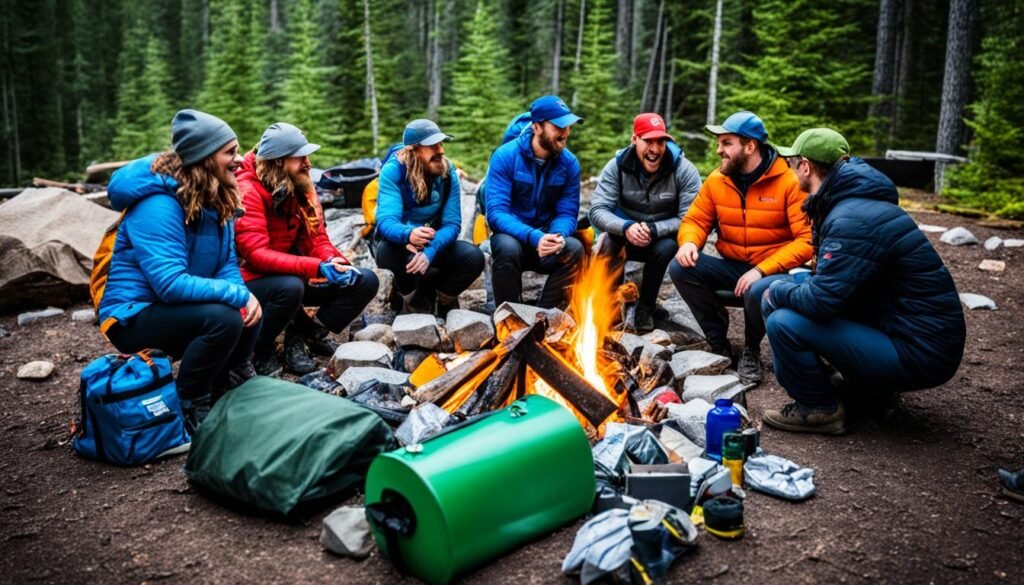
Good manners at the campsite make everyone’s visit better. When on the river, remember canoes and kayaks go before powerboats. This makes travel safe and orderly. Slower boats should stay to the right to help everyone move along smoothly.
Keeping the outdoors quiet and natural is key. Don’t camp or eat close to big rapids. This helps others scout and carry their boats if needed. Keep music and noise low to enjoy the sounds of nature.
Following these tips makes outdoor adventures better for all. Good campsite manners let us all enjoy nature’s beauty. Let’s make sure everyone has a wonderful time outdoors.
Educating Others About Leave No Trace
Talking about eco-friendly canoe camping matters. We must teach others to Leave No Trace. This way, we work together to keep nature safe. We can use signs, talk directly, and show how to do things right.
Leave No Trace works well. It has cut soil erosion by up to 92%. And, it has reduced trail damage up to 81%. These facts show we need to keep teaching people to care for the outdoors.
The Leave No Trace group started in the 1960s. It works with others like the US Forest Service. Together, they make rules to protect nature. Practicing these rules makes a big difference in keeping the outdoors beautiful.
It’s important to teach how to deal with trash right. And to show how to act outdoors. Working with artists like Simon Beck is smart. He makes art in snow to spread the word. Companies like Outdoor Master join in too. They support actions like Protect Our Winters (POW).
Educating on Leave No Trace is key for a green future. This helps make sure nature stays beautiful for all. Our efforts mean the wild will be there for years to come.
Benefits of Practicing Leave No Trace
Practicing Leave No Trace helps keep nature beautiful and available for all. It makes sure we can keep enjoying the outdoors. Research shows that by using Leave No Trace, we can greatly reduce soil erosion and keep trails narrow.
Leave No Trace has seven key rules to protect ecosystems and animals. These rules help keep the earth clean and safe. By using a fuel stove instead of campfires, we can stop harm to the environment.
Following Leave No Trace is good for the planet and our adventures. It ensures future generations can see nature as we do. Products like Eco-Friendly Ski Goggles show this commitment. They’re made almost entirely from stuff that breaks down. Collaborating with artists like Simon Beck shows the beauty of preservation. Leave No Trace is our guide to enjoy nature without harming it.

